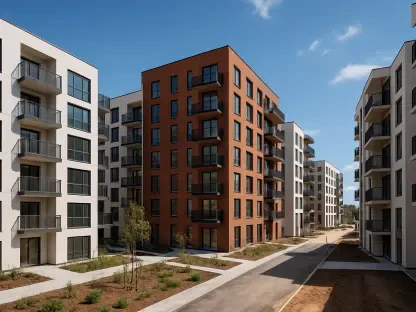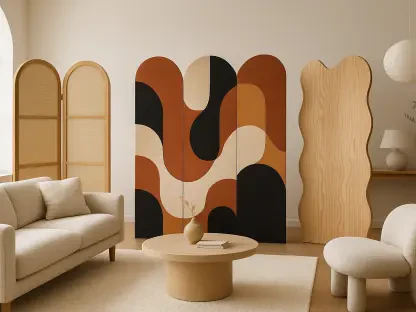As city dwellers continue to transition from larger country homes to more compact urban apartments, the way individuals perceive their living spaces undergoes significant changes. This shift not only challenges traditional ideas about what constitutes essential home decor but also invites a re-examination of personal style and practicality. The ongoing trend of downsizing reflects a broader cultural movement toward minimalism and personal expression, shaped by the necessity to accommodate smaller, more efficient city residences.
Rethinking Home Decor Essentials
The Minimalist Mindset: Needs Over Wants
Downsizing into urban apartments compels homeowners to reconsider which decorative elements truly serve them. It often necessitates distinguishing between mere wants and actual needs, fostering a minimalist mindset. This approach prioritizes functionality and purpose over sheer accumulation of items. Many find that once they commence decluttering, they are enlightened by how few items are necessary for comfort and happiness.
In the evolving landscape of urban living, this minimalist philosophy underscores the importance of purposeful possessions. Items are now selected based not only on aesthetic appeal but also on their ability to fulfill multiple roles within the home. The goal is to create a space where every piece of decor holds personal significance and utility, enriching the living environment without contributing to clutter. This shift reflects a growing awareness that happiness in the home comes from meaningful and functional decor, not abundance.
Emotional and Practical Considerations
Urban downsizing invites a reflective process where individuals evaluate the emotional resonance and practical use of their possessions. This exercise pushes people to identify which items contribute to their well-being and personal expression. By focusing on what truly matters, homeowners can craft spaces that reflect their identities and support their lifestyles in a meaningful way.
In this context, sentimental items are often preserved but must earn their place by serving a practical role or contributing to the ambiance of the space. Decorative elements like vases, candlesticks, and art pieces, which might seem non-essential, gain importance as expressions of personality and style. They transform living spaces into personalized sanctuaries, making apartments feel like home despite the reduction in size. This balance of sentiment and functionality creates a harmonious atmosphere that caters to both emotional needs and practical living requirements.
The Influence of Changing Lifestyles
Impact of Global Events on Home Design
Recent global events, like the COVID-19 pandemic, have significantly influenced home design and functionality, underscoring the importance of versatility in urban dwellings. The necessity to adapt living spaces to serve dual purposes during lockdowns highlighted the roles of furniture and decor in facilitating new lifestyles. Sofas, for example, became makeshift office spaces, illustrating the need for furnishings that can transform to accommodate different functions seamlessly.
This adaptability reflects a new paradigm in home decor, where flexibility is paramount. Furniture and decor elements are chosen for their ability to transition from one function to another with ease. This ensures that limited space is used efficiently, allowing residents to maintain productivity and comfort without the luxury of excess square footage. As lifestyles continue to evolve, the focus on flexible design is expected to persist, reinforcing the need for decor that supports a multi-faceted urban lifestyle.
Emphasizing Function and Comfort
In compact urban settings, the dual emphasis on function and comfort drives decor choices. The need for practical and versatile furniture has never been more pronounced, particularly as home offices and multipurpose living areas become standard in city apartments. This trend gravitates toward items like ergonomic office chairs, multifunctional tables, and decor elements that also provide comfort and utility.
Comfort becomes a critical criterion, influencing not just the choice of larger furniture pieces but also smaller decorative elements like throw pillows and rugs. These items must blend aesthetics with the ability to create a cozy and inviting environment. The decor must adapt to the space without overwhelming it, ensuring it remains a sanctuary that supports daily activities and offers respite from the bustling city exterior. This balance between functionality and comfort enhances the home’s livability and ensures that every element contributes positively to the resident’s lifestyle.
Redefining Space through Personalization
Curating a Personalized Environment
The pressure of fitting life into smaller urban apartments prompts a departure from generic decorating trends and encourages a more personalized approach to home design. Homeowners are increasingly focused on curating environments that resonate with their tastes and personal histories. This shift highlights the value of unique, meaningful items over mass-produced goods, with personalization becoming a key component of modern interior design.
Personal artifacts and heirlooms often take precedence, actively shaping the narrative of a home. These pieces not only occupy physical space but also infuse the home with character and depth. Personalizing space transforms apartments into reflections of the individual, creating an environment where residents feel deeply connected and comfortable. This personalized approach also fosters an atmosphere that is distinctly one’s own, setting homes apart from identical urban spaces that lack individuality.
The Role of Sentimental Value
As individuals downsize, choosing decor often involves a consideration of emotional resonance and personal value. Sentimental objects that offer comfort or cultural connection are given priority, reinforcing the idea that homes are as much emotional havens as they are physical structures. This focus ensures that even in a downsized dwelling, the home remains a place of warmth and personal significance.
These treasured items, whether inherited family photographs or cherished holiday souvenirs, act as anchors in the transition to smaller urban spaces. They serve as reminders of cherished moments and experiences, enriching the home environment. The curation of such meaningful elements helps maintain a sense of continuity and belonging, anchoring residents as they navigate the shift to more compact city living arrangements. Integrating sentimental decor transforms downsizing from a daunting task into an opportunity to celebrate personal history and individuality.
Future Directions for Urban Living
Embracing the Shift to Purposeful Minimalism
As urban downsizing continues to shape home decor trends, purposeful minimalism emerges as a dominant force guiding design choices. This philosophy prioritizes efficiency, sustainability, and aesthetics, encouraging homeowners to live more intentionally. The approach promotes acquiring fewer, but more valuable and versatile, decor pieces, which serve practical purposes and contribute to visual appeal.
The purposeful minimalist movement advocates mindful curation, where each decor choice is carefully considered and serves a specific function or aesthetic purpose. This trend aligns with growing environmental consciousness, as it reduces waste and supports a more sustainable lifestyle. By embracing purposeful minimalism, urban residents can create living spaces that fulfill their immediate needs and resonate on a deeper level, promoting well-being and environmental responsibility.
Adapting to Evolving Urban Spaces
The dynamics of urban living are continuously changing, driven by increasing population densities, technological advancements, and shifts in work-life balance. Adapting to these changes involves rethinking spatial organization and decor choices. Homeowners must remain agile, selecting decor that evolves with their needs, ensuring their living environments remain functional and inviting.
As urban areas expand and adapt, selecting decor that complements evolving city landscapes becomes crucial. Home furnishings must cater to current needs and anticipate future requirements, offering solutions that adapt to changing circumstances. This adaptability helps residents maintain a balanced and harmonious living environment, ready to meet future challenges while preserving the elements that make a house feel like home.
Reflection on Urban and Decor Dynamics
As more people move from spacious country homes to smaller urban apartments, the way they view their living spaces is undergoing a seismic shift. This transition challenges conventional notions of what is considered essential in home decor and prompts a reassessment of one’s personal style and the practicality of living arrangements. The trend toward downsizing is indicative of a broader cultural movement embracing minimalism and personal expression. This movement is largely driven by the need to optimize and adapt to smaller, yet more efficient city residences.
In urban settings, where space is at a premium, individuals are increasingly prioritizing functionality and simplicity over excessive furniture or decorative items. This doesn’t mean sacrificing style; rather, it encourages a curated environment that reflects personal taste while meeting practical needs. Minimalism offers a lifestyle that values quality and intentionality, allowing city dwellers to make the most of their compact spaces.
Moreover, the shift toward urban living often aligns with a desire for a more sustainable lifestyle. Smaller homes mean fewer resources needed for maintenance and heating, which can be better for the environment. This move toward green living complements the minimalist approach, making it as much an ecological choice as an aesthetic one. Overall, relocating from expansive homes to urban apartments signifies not just a change in scenery but a profound transformation in living philosophy.









